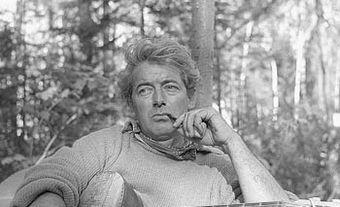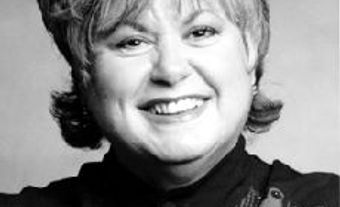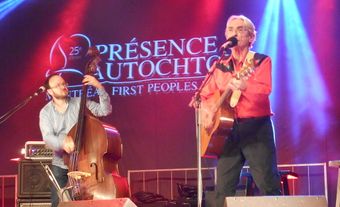Diane Dufresne, CQ, CM, singer, actress, writer, painter (born 30 September 1944 in Montreal, QC). The first female “rocker” of the francophone world, Diane Dufresne is a popular singer whose dramatic manner and highly distinctive, provocative vocal style have been strongly identified with Quebec. Often compared to Édith Piaf for her sensitive and powerful performances, Dufresne was one of the most popular performers in France in the 1980s. Nicknamed "La Diva" and "La Dufresne," her performances in Quebec are synonymous with sold-out houses. She has won the Governor General's Performing Arts Award and several Félix Awards and has been inducted into the Canadian Music Hall of Fame. A Member of the Order of Canada, she is also a Chevalière of the Ordre national du Québec and France’s Ordre des arts et des lettres and Legion of Honour.
Early Years and Career
As a teenager, Dufresne began singing in Montreal and took lessons in 1957 with Simone Quesnel. From 1965 to 1967, she studied voice with Jean Lumière and dramatic art with Françoise Rosay in Paris; and sang in such boîtes à chansons as l'Écluse, l'Échelle de Jacob and le Caveau de la Bolée. Returning to Montreal, she appeared in Clémence Desrochers' revue Les Girls (1969), and began a collaboration with the composer François Cousineau and the lyricist Luc Plamondon, who later wrote many of her most popular songs.
Career Highlights
Dufresne sang in studios (for commercial jingles, etc.), then made her first LP in 1972. The song “J'ai rencontré l'homme de ma vie” (1972) was a huge hit (60,000 copies sold in Québec and 125,000 in France). She then opened a show for French singer Julien Clerc at the Olympia in Paris in 1973, to a mixed reception. The Montreal Star’s Juan Rodriguez wrote, “Her joual is even cruder than Charlebois's... her costumes are legendary and her vocal style is more hysterical than anything France has ever seen.”
Dufresne moved to the forefront of pop performers in Québec in the mid-1970s with her LPs Sur la même longueur d'ondes, Mon premier show (1975, recorded at the Place des Arts), and Maman si tu m'voyais... tu s'rais fière de ta fille (1977), with the 1975 hit single “Chanson pour Elvis,” and with such shows as Comme un film de Fellini (1978) on the Montreal stage. In France she received the Prix jeune chanson from the French Music Exchange Association and performed at the Élysée Montmartre in Paris in 1977. She returned to the Olympia on 14 March 1978 to great acclaim; her concerts there yielded two live albums. She also appeared in several French TV specials in 1978 and 1979. In Paris in 1979, she played the role of Stella Spotlight alongside several Québec and French pop stars in Plamondon and Michel Berger’s rock musical Starmania. “Les adieux d’un sex-symbol” from the LP of Starmania (Kébec-Frog KF 8001-2) was a hit in France in 1979. “Rock pour un gars d'bicyc,” “Tu m'fais flipper,” “La chanteuse straight,” “Le parc Belmont,” “J'ai douze ans maman,” “Pars pas sans me dire bye bye” and “Turbulences” are also some of her greatest hits.
During the 1980s, Diane Dufresne became one of the most popular performers in France, where she appeared in Philippe Chatel's musical tale Émilie Jolie. The rock musical Dioxine de carbone, composed for her by Plamondon, opened to a mixed reception at the Cirque d'hiver de Paris in 1984. Subsequently, the duo ceased collaborating. Also in 1984, Dufresne gave the celebrated show Magie rose before an audience of 55,000 at Montreal's Olympic Stadium. In 1986, she staged Top Secret at the Théâtre du Nouveau-Monde in Montreal, where she performed “Addio del Passato” from Verdi's La Traviata. With Top Secret she won the Félix Award for best pop show of 1987. The next year, she presented Symphonique n’Roll at the Québec Coliseum with the Québec Symphony Orchestra and at the Festival d'été de Lanaudière (now the Festival international de Lanaudière), as well as in Japan and Paris. She was part of the St-Jean-Baptiste celebrations on the Plains of Abraham in Québec City and on St Helen's Island in Montreal in 1990.
In the early 1990s, Dufresne began writing and recording her own songs, turning away from rock in favour of a more subdued sound. Her shows became more reserved, even mellow. Her 1998 show, Réservé, won two Félix Awards. In a 2004 appearance with the Orchestre métropolitain du Grand Montreal, conducted by Yannick Nézet-Séguin, she explored the songs of Kurt Weill, the recording of which won a Félix Award. In 2006, she performed alongside k.d. lang, Deborah Cox and Cirque du Soleil at the opening ceremonies of the first World Outgames at Montreal’s Olympic Stadium.
Also a painter and actress, Dufresne has exhibited her paintings in Québec, the US and Europe, and acted in films, such as Francis Leclerc’s Une jeune fille à la fenêtre (2001). She contributed illustrations to Bruno Roy’s 2009 book, Les cent plus belles chansons du Québec; and continues to perform on tour, and at festivals in Canada and France.

Honours and Legacy
In the words of writer Jacques Godbout, in France Diane Dufresne became “the image of modern Québec — turbulent, delinquent.” She received a Lifetime Achievement Award at the ADISQ gala in 2006, and was made a Chevalière of the Ordre national du Québec (2002) as well as France’s Ordre des arts et des lettres (2001) and Legion of Honour (2008). She was made a Member of the Order of Canada in 2015 and was inducted into the Canadian Music Hall of Fame in 2023.
A version of this entry originally appeared in the Encyclopedia of Music in Canada.
Awards
- Pop Music Show of the Year (Top Secret), Félix Awards(1987)
- Show-writer of the Year (Réservé), Félix Awards (1998)
- Chevalière, Ordre des arts et des lettres, Government of France (2001)
- Chevalière, Ordre de la Pléiade, International Assembly of French-Speaking Countries (2001)
- Governor General's Performing Arts Award(2001)
- Chevalière, Ordre national du Québec(2002)
- Album of the Year — Classical Orchestra and Large Ensemble (Diane Dufresne, Kurt Weill, Yannick Nézet-Séguin, Orchestre Métropolitain du Grand Montreal), Félix Awards (2005)
- Lifetime Achievement Award, Félix Awards (2006)
- Chevalière, Legion of Honour, Government of France (2008)
- Member, Order of Canada (2015)
- Inductee, Canadian Music Hall of Fame (2023)

 Share on Facebook
Share on Facebook Share on X
Share on X Share by Email
Share by Email Share on Google Classroom
Share on Google Classroom




